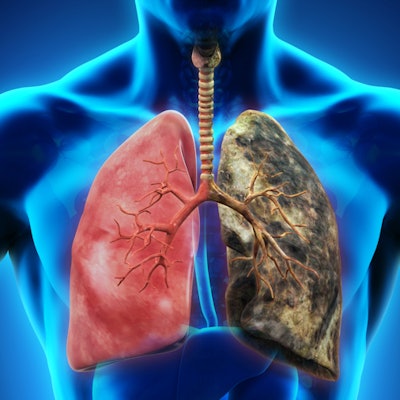
CT lung cancer screening has been shown to reduce mortality when administered to high-risk smokers, but a new study is questioning whether the right metrics are being used to demonstrate this reduction, according to an article published online June 7 in JAMA Oncology.
Some proponents of CT lung cancer screening previously projected that it could reduce lung cancer mortality by as much as 80%, but large-scale, randomized studies including the National Lung Screening Trial (NLST) have demonstrated no greater than a 20% reduction in mortality, according to senior author Dr. Peter Bach and colleagues from Memorial Sloan Kettering Cancer Center and the Medical University of South Carolina.
However, the researchers of many of these trials were obligated to stop testing and start offering CT screening to all participants as soon as it demonstrated a 20% reduction in lung cancer mortality. They used various markers to determine that CT lung cancer screening led to a 20% reduction in mortality during the study, including the following:
- Increased detection rate of lung cancer with CT
- Increased survival of participants with lung cancer at four years after screening
- Greater proportion of lung cancers diagnosed with CT compared with the control group (i.e., x-ray screening)
Not satisfied with these "surrogate markers," Bach and colleagues assessed the relationship between these markers for CT screening and the reported 20% reduction in lung cancer mortality.
When they analyzed data from the NLST using statistical software, they found that the 20% reduction in lung cancer mortality reported in the NLST did not have a statistically significant correlation with either the detection of lung cancer with CT or the four-year survival rate of participants with lung cancer.
| Correlation between mortality reduction and surrogate markers | ||
| Markers of screening benefit | Reduction in lung cancer mortality | p-value |
| Proportion of lung cancers detected with CT | -0.08 | 0.65 |
| Lung cancer survival rate at four years | -0.28 | 0.13 |
Although CT screening detected lung cancer in more participants and increased their four-year survival rate compared with the control method, these benefit markers did not positively correlate with a reduction in lung cancer mortality, the authors noted.
"Some researchers have considered improvements in surrogate markers of screening benefits to be synonymous with evidence that CT screening is improving patient outcomes," they wrote. "Yet our analysis suggests that drawing such a conclusion is inappropriate."
If these predictive markers of the benefits of CT lung cancer screening are inappropriate, what markers should clinicians look for instead? Though the authors do not point out any new benefit markers, they do suggest the need to seek out more dependable ones.
"A quest for more reliable predictive markers of CT screening impact on patient outcomes is warranted," they wrote.




















